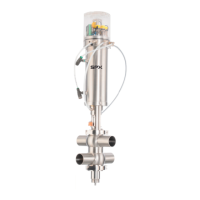Waukesha Cherry-Burrell Care of Stainless Steel
10/2012 95-03087 Page 7
Care of Stainless Steel
Stainless Steel
Corrosion
Corrosion resistance is greatest when a layer of oxide film is formed on the sur-
face of stainless steel. If film is disturbed or destroyed, stainless steel becomes
much less resistant to corrosion and may rust, pit or crack.
Corrosion pitting, rusting and stress cracks may occur due to chemical attack. Use
only cleaning chemicals specified by a reputable chemical manufacturer for use
with 300 series stainless steel. Do not use excessive concentrations, tempera-
tures or exposure times. Avoid contact with highly corrosive acids such as hydro-
fluoric, hydrochloric or sulfuric. Also avoid prolonged contact with chloride-
containing chemicals, especially in presence of acid. If chlorine-based sanitizers
are used, such as sodium hypochlorite (bleach), do not exceed concentrations of
150 ppm available chlorine, do not exceed contact time of 20 minutes, and do not
exceed temperatures of 104°F (40°C).
Corrosion discoloration, deposits or pitting may occur under product deposits or
under gaskets. Keep surfaces clean, including those under gaskets or in grooves
or tight corners. Clean immediately after use. Do not allow equipment to set idle,
exposed to air with accumulated foreign material on the surface.
Corrosion pitting may occur when stray electrical currents come in contact with
moist stainless steel. Ensure all electrical devices connected to the equipment are
correctly grounded.
Elastomer Seal
Replacement
Following
Passivation
Passivation chemicals can damage product contact areas of this equipment. Elas-
tomers (rubber components) are most likely to be affected. Always inspect all
elastomer seals after passivation is completed. Replace any seals showing signs
of chemical attack. Indications may include swelling, cracks, loss of elasticity or
any other noticeable changes when compared with new components.

